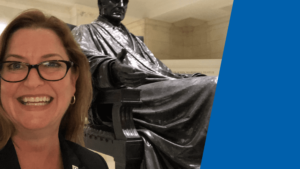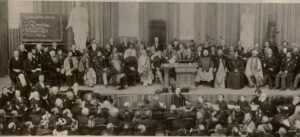Experimenting with Freedom of Conscience
Today we continue our exploration of Teaching American History’s two-volume document collection, Documents and Debates in American History and Government
Almost exactly 230 years ago—on August 17, 1790—President George Washington arrived in Newport, Rhode Island. He was there to welcome the state, which had recently ratified the Constitution, into the Union. But his visit also affirmed his support of a political ideal that had been forming in America for nearly 200 years. Washington and his entourage walked the port city during the day and dined with Newport’s distinguished citizens that evening. One of Newport’s merchants, Moses Seixas, warden of the Touro Synagogue, greeted Washington, telling him that the Jews in his congregation were grateful to live under a government “which to bigotry gives no sanction, to persecution no assistance.”
Four days later, Washington wrote to the Hebrew Congregation at Newport, thanking them for their gracious welcome. He reflected on the days of “difficulty and danger” in the past, expressed hope that a wise administration would give rise to “a great and happy people,” and celebrated the new nation’s “enlarged and liberal policy” granting all citizens “liberty of conscience.” Washington echoed the words of Moses Seixas, agreeing that “the Government of the United States … gives to bigotry no sanction, to persecution no assistance.” He closed the letter prayerfully, expressing hope that every American Jew would “sit in safety under his own vine and fig tree and there shall be none to make him afraid.
Several years ago, I traveled to Newport to participate in a Teaching American History Multi-Day Seminar on religious freedom. We toured the Touro Synagogue, the home synagogue of Moses Seixas, whose congregation was the recipient of Washington’s letter. I was familiar with Washington’s note to the Hebrew Congregation of Newport before that weekend’s seminar, but I was visiting the synagogue for the first time. It was a sacred moment in my life. As I sat in the pews of America’s oldest synagogue, I felt a connection to the struggle for religious freedom often denied to Jews and other minority religions worldwide.
The Founding generation often referred to the American republic as an experiment. Implicit in Washington’s letter to the Hebrew congregation is his awareness that liberty of conscience was a key element of this experiment. In the colonial era, only Pennsylvania, Delaware, and Rhode Island “failed to establish a particular denomination … “ as the officially recognized faith. It was far more common for the colonies to favor particular sects of Christians with public funds and legislative protection. Nevertheless, from the Pilgrims’ first landing in 1620 to the imperial crisis of the 1760s and 70s, American colonists increasingly saw religious freedom as a natural and inalienable right, intimately connected to other political rights.
While many colonists wished to strengthen the Church of England in America, they did so against a growing tide of religious diversity. Today, Americans enjoy such a varied array of religious options that we can take religious freedom for granted, assuming that its birth, growth, and maturation in America was automatic. It was not.
Our Documents and Debates collection presents the story of this developing ideal in Chapter 4, Experiments with Freedom of Conscience. As the colonists established their foothold in the New World, legislatively established religion was common. Religion was seen as good for civic order because it encouraged citizens to act virtuously. Even as the colonies began to embrace religious tolerance, they either maintained religious establishments or encouraged church attendance as a prerequisite for civil society. (See Document A). The growth of religious diversity led some colonists to equate religious freedom with political rights. Others sought deeper ties to the Church of England to strengthen the British colonies’ ties to the Crown.
Documents in this chapter include:
- William Penn, Pennsylvania: Frame of Government, 1682
- Pennsylvania: An Act for Freedom of Conscience, 1682
- John Miller, “As to their religion, they are very much divided,” 1695
- Benjamin Franklin, George Whitefield Preaches in Philadelphia, 1739
- Elisha Williams, The Essential Rights and Liberties of Protestants, 1744
- Gottlieb Mittelberger, “Liberty in Pennsylvania is more hurtful than useful,” 1750
We have also provided audio recordings of the chapter’s Introduction, Documents, and Study Questions. These recordings support literacy development for struggling readers and the comprehension of challenging text for all students.
We the Teachers blog is featuring Documents and Debates with their accompanying audio recordings each month until recordings of all 29 chapters are complete. In today’s post, we feature Volume I, Chapter 4: Experiments with Freedom of Conscience. On September 22, we will highlight Chapter 19: The Progressive Era: Eugenics from Volume 2 of Documents and Debates in American History.
Additional Documents on Freedom of Conscience in Teaching American History’s document database include:
- Letter to the Hebrew Congregation at Newport, George Washington, August 21, 1790
- Property, James Madison, March 29, 1792



